Rabbids: Alive & Kicking Review
 Game: Rabbids: Alive & Kicking
Game: Rabbids: Alive & Kicking
Developer: Ubisoft
Publisher: Ubisoft
Available on: Kinect for Xbox 360 only
Having first made their debut rather inconspicuously in one of the Rayman platforming titles, the creator of the Raving Rabbids – Michel Ancel – set to task to employ his new creations in their own game.
This has resulted in popular series of mini-game collections and party titles, that places the insanity of the Rabbids at the centre of their philosophy. Largely having been Wii or DS based games so far – due to their unique input methods, the title is now trying to make an impact on Xbox 360 – thanks to the Kinect hardware. No other control method can lend itself quite so well to the embarrassment and multiplayer madness as the full-body control of Kinect – so does Alive & Kicking result in a home run for the series, or does it simply provide more of what we have come to expect.
STORY: The tale is a familiar one. The Rabbids have been secretly living underground for years and both studying our lives and carrying out strange experiments. One of these experiments results in the mass multiplication of the rabbity creatures, and they begin to spill out and erupt like volcanoes into the human world. In the game, players will assume the roles of the different humans who are trying to cope with the Rabbid menace throughout the city. This ranges from muscle men defending the beach, cheerleaders helping out at the football stadium and superheroes protecting the in-game homage to the Golden Gate Bridge. There is no real cohesion and progression to the story, it is rather just a loose theme which is used to tie together the disparate variety of mini-games. But to be honest, you won’t really be thinking of the story when playing the game. It is all about flailing your limbs and performing crazy actions – preferably with a group of friends – and story takes a firm back-seat.
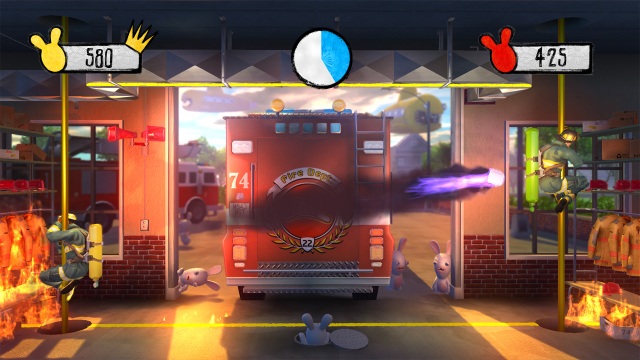
GRAPHICS: Finally, high-definition Rabbids come into your living rooms. Although a lot of the game is presented in full 3D, with avatar tracking and player image integration included, the game also shines in it’s two-dimensional cartoon-style imagery. In different mini-games, a variety of graphical styles are employed. These are well chosen and tend to fit the game well – those games in which your body movements are tracked closely on-screen feature 3D full body avatars in colourful locations, such as the strike a pose activity, but there are also a handful of activities that take place in your own living room. Looking through a rendered window, your own lounge is projected onto the screen and – through the implementation of augmented reality, Rabbids appear alongside you and wander around your furniture!
This is probably the point at which most players will be impressed with the visuals – as the idea of Augmented Reality, and being placed directly into the action, is still quite a novel one. The Kinect sensor handles this all very well, and there is very little graphical lag between you performing the action and it appearing on-screen – certainly nothing noticable. The thing that I felt looked really impressive in high definition however was the mini-games that are handled entirely as 2D cartoons. The drawings are crisp, clear and bright, and full of character. Although they might not have the immediacy of your image being placed into the game, they capture the madness of the Rabbids exactly, and I’d quite happily watch an entire Television series put together in this style.
SOUND: The sound consists of the usual screams, laughs and gurgles that those little white creatures produce, and whilst this is no different from past games, the sounds are all sufficiently amusing in that it still adds to the charm of the animals in question. Music is generally stock tunes, and other sound effects are all fairly basic – and whilst the games doesn’t really excel in this department, none of the audio elements effect the experience negatively.
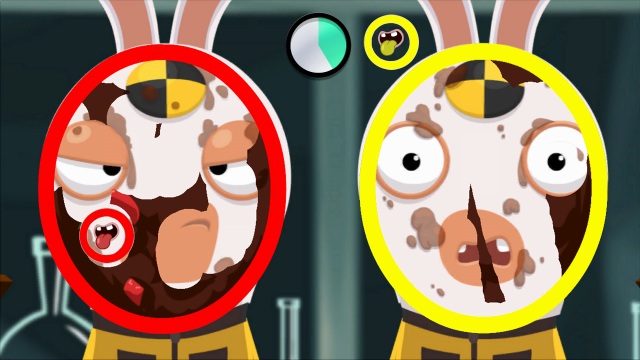
GAMEPLAY: In single-player, the gamer can play with their own Rabbid in their living room – where you can slap, kick and punch your rabbity friend, as well as buy clothes and accessories for them and taking photos of your creations. This is a little like a virtual pet, but there is nothing much to this mode. Aside from that, the only options for the solo player are to randomly play any of the single-player games, or to pick the ones you wish to try from the full list – there is no story mode or the like, and the only constant is that you are awarded toilet paper for successfully completing tasks, which can then be spent on new items for your Rabbid. With around forty different mini-games on offer, it would be difficult to outline all of the different activities you will find yourself involved in. To briefly brush across it though, you will find yourself swimming, jumping, head-banging, posing, running, stomping, dancing, spinning in circles, riding virtual Horses and “shaking that ass”. The variety of physical actions you will have to go through is impressive, with few of the games simply feeling like filler or a clone of another previous one.
It should also be said that the Kinect sensor is very accurate at tracking your actions in the title, and little movements really will be noticed. For instance, in the Muscle Beach posing mini-game, players will have to mimick the poses shown on-screen, in order to inflate the muscles on their own Avatar and fill a meter before time runs out. The game is surprisingly accurate, and you will have to match the pose very closely in order to quickly pass the task. The game is slightly forgiving, in the sense that if one foot is in the wrong position your meter may still go up, but quite slowly – whereas if you position yourself very closely to the source image, the meter will visibly fill up much more quickly.
Interestingly, the game features many Rabbidy takes on popular games of old. The Augmented Reality Whack-a-Mole game for instance, is a great idea. Whilst your living room is shown on-screen, Rabbids pop up out of the floor, and you have to jump or stamp on their heads as they get faster and faster. This works just like a normal Whack-a-Mole game would, and both the response time and the reactions of the Rabbids on-screen are very satisfying. Other popular games that are parodied here are; a version of Arkanoid where you control a fireman repelling flaming marshmallows which the Rabbids hurl at you, and a lengthy game that is obviously based on Lemmings. In this game, you must use your hands (and your mouth) to activate switches and platforms, that will guide your Rabbids home safely. The Rabbids simply walk froward, turning when they hit a wall – and this all feels very like an early Lemmings title. In later levels, as the difficulty ramps up, you will find yourself having to use head and both hands at once to activate items, as you try to save all of your Rabbids from death.
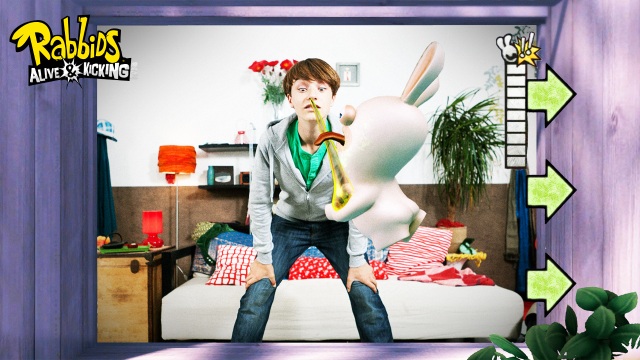
Aside from a handful of quick-response question and answer rounds, the mini-games are all rather physical, challenging your fitness and reactions rather than your mind. Strategies will often fly out of the door as the action gets fast and furious, but there are clearly certain ways to approach each game successfully. First time round, most of the puzzles will be a little confusing, but the controls are generally quite obvious. By using full body control, if the game tells you to jump, it is simple to reason what needs doing. The same goes for running, dancing or even Horse riding. It is the fact that each control method comes quite naturally to the player – experienced or not – that makes the title so accessible and therefore a great choice at a party.
MULTIPLAYER: It should be said that whilst the single-player options are rather sparse, the multiplayer offering is where the action is at. Again, you can choose to play a selection of games for 1-4 players, randomly thrown at you, or by selecting them off the list. This works in the same way as the single-player mode, albeit allowing you to play more games that aren’t available to the sole player. On top of that, there are several Party modes to play through. Suitable for three players, all the way up to sixteen – each of whom get to take their photo and record a voice clip when creating their profile – the game can accomodate huge parties.
The three different party modes are “The Kitty”, “Carrot Juice” and “Forfeits”. Forfeits has gamers taking turns to play random head-to-head games with another random player, with the loser having to perform a forfeit in front of the other players. They will then vote on whether or not the Forfeit was successfully performed, and if they pass or not. These Forfeits are (of course) pretty ridiculous, but they will liven up a party as they will allow players to make a fool of one another. The Kitty works a little like The Weakest Link. Players take turns to play individual mini-games, earning points for each one. The number of points awarded rises with each successful game completed, and between successful games, players can choose to bank their winnings, or to gamble it until the next round. Play progresses until a certain number of rounds have played out, and the winner is the one with the highest total.
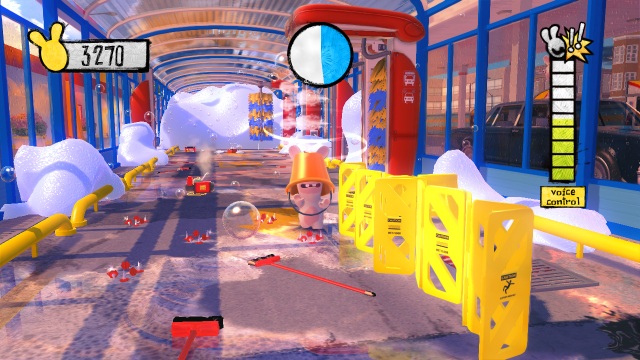
Finally, Carrot Juice arms gamers with four shots of Carrot Juice each – these act as lives. They then must each spin a Wheel of Fortune, that will decide the type of game they will play, whether it be solo, two-player or something else. They then have to successfully complete a task, in order to keep their lives intact. Losing a round will result in one shot being drunk, and the last player with any shots left is the winner. In a funny twist, if another player is chosen to play alongside the active player, and they lose their task, both players lose a life – so there will be no sabotaging of each others games here. These different modes all make the game much more exciting and competitive when played with three or more gamers, and really shows how the game can shine with fast-paced, random activities challenging the players. The Rabbids series has always been designed for Party play, and this game is certainly no different.
LONGEVITY: The number of different mini-games is pretty impressive, and the fact that some of the games – such as the Lemmings-inspired one – have multiple stages and difficuly levels, does mean that you will find yourself coming back again and again in order to try all of the different games on offer. It will also take quite some time for players to achieve three-star ratings on each game. On first playthrough, you will normally only achieve a one-star rating, so practice and repeat playthroughs will allow you to better your scores and earn more toilet paper.
Sadly, the rewards that can be purchased with TP are pretty inconsequential, as the Rabbid pet mode is pretty shallow, meaning that earning TP is slightly pointless. There are of course achievements to aim for, which are awarded for a variety of actions, and some of these are quite tough – so you could be playing for a while in order to attain them all. But really, the game won’t keep you occupied for long when playing solo – whereas the multiplayer games are so silly and so much fun to act out, that you will find this game becoming a party go-to game for quite some time.
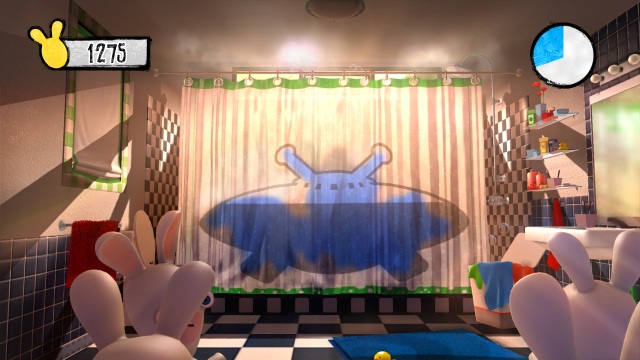
VERDICT: Your opinion of the game will no doubt depend greatly on whether or not you enjoy party games, and if you will regularly have the opportunity to get three or four friends or more around, to fully enjoy all of the different multiplayer modes. The single-player is quite clearly lacking, with no story mode or progression of any sort to speak of. This is a shame because (although the game is obviously aimed at party play) there will inevitably be times when the player might wish to play alone. It seems a missed opportunity not to include a stage-based mode or challenge mode, just to give the solo player some sense of achievement and completion.
That said, the game is a whole lot of fun whe played with friends. The great variety of different modes, each with their own activities and action to carry out, will keep groups of gamers in stitches for a long time. The games featured make the player wilfully embarrass themselves and lose some of their inhibitions, which is always likely to create a fun and silly party atmosphere. The photo taking and sharing features only make it more enjoyable to capture those laugh-out-loud moments.
Although this is far from a revolution when compared to previous Rabbids titles (a few of the mini-games on show here are even recycled from previous entries, simply with new controls), the gameplay has been refined and fits the Kinect sensor like a glove. Whereas some of the mini-games featured in the past were difficult to pick up, Kinect makes it much simpler to pick up and play intuitively – and that is probably the biggest hurdle that always held back the Wii entries in the series. Now anyone can play Rabbids, without really knowing what to do, and that is a sign of a developer that really understands the strengths of the device.






